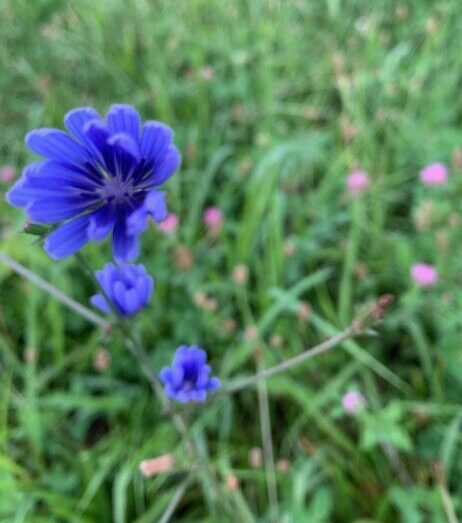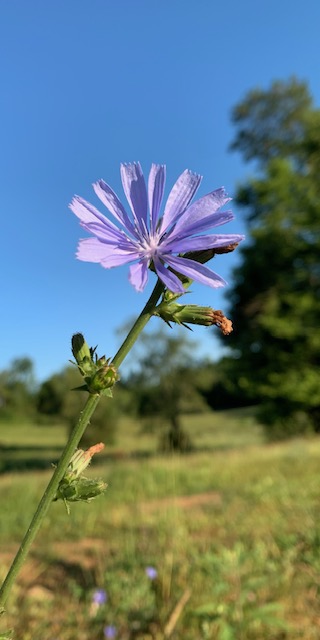This is a common flower here on the farm, but one I’m finding out tonight that I didn’t know all that much about. I grew up calling it cornflower, maybe because it’s a weed common in corn fields. That’s a guess. It turns out that common chicory has many names. It is also known as blue daisy, blue dandelion, blue sailors, blue weed, bunk, coffeeweed, hendibeh, horseweed, ragged sailors, succory, wild bachelor’s buttons, and wild endive.
Chicory is not native to America.  It was brought to North America by the early European colonists. Some suggest the seeds were probably brought over in the bedding for cattle and other stock that came on the ships with those settlers. Once the seeds were here, chicory thrived. It is considered an invasive plant, but in my thinking, one of the nicer ones. I’ve always liked seeing the pretty blue flowered weeds among the pasture or hayfield grasses. It blooms profusely in the last months of summer, a cheery blue. Some of the blooms are a light blue and some dark blue. The flowers close up at night and open to the sun in the mornings. Bees, butterflies, and various bugs like the blooms.
It was brought to North America by the early European colonists. Some suggest the seeds were probably brought over in the bedding for cattle and other stock that came on the ships with those settlers. Once the seeds were here, chicory thrived. It is considered an invasive plant, but in my thinking, one of the nicer ones. I’ve always liked seeing the pretty blue flowered weeds among the pasture or hayfield grasses. It blooms profusely in the last months of summer, a cheery blue. Some of the blooms are a light blue and some dark blue. The flowers close up at night and open to the sun in the mornings. Bees, butterflies, and various bugs like the blooms.
That’s about all I knew about chicory before I went online. I have obviously missed out on all the amazing things about chicory while thinking it was just a pretty weed that showed up every summer. So here goes with more than you ever knew you wanted to know about cornflowers, er, chicory.
It is said to like limestone soils which are plentiful in my area. It is drought resistant. One site online said the leaves can be eaten in a salad or as a vegetable. The plant is part of the dandelion family and has similar leaves at the ground level of its stem. I did know dandelion leaves could be picked to cook as greens. The chicory root can be boiled and eaten with butter.
Chicory has also been long used as a coffee substitute. Confederate soldiers were said to have used it during the Civil War, and supposedly, it’s been long used as a coffee substitute in prisons.
By the 1840s, New Orlean was the second largest importer of coffee after New York. During the War between the States, the Union navy blockaded the New Orleans port and cut off many imported supplies, including coffee. Louisianans started adding ground chicory root to their coffee to make it last longer and perhaps using it solely for their coffee. That created a tradition still alive today in New Orleans. Roasted and ground chicory root adds color, body, and bitterness to coffee. You can buy chicory flavored coffee online or the ground chicory root. You can also find chicory tea. I didn’t make an order.
Much like a carrot, chicory has a taproot. If you want to try to harvest it, you need to get a shovel deep under the long root to keep from breaking it. Here is a link to a blog post on The Little Black Coffee Cup that goes into detail about harvesting chicory to make some coffee. I’m not planning to give it a try, but if I did, I’d be boiling the roots for tea instead of grinding them for coffee.
There is documentation that ancient Europeans consumed chicory root to purify the liver and blood. Current studies claim that the root, packed with prebiotics and rich in fiber, can support healthy weight loss.
Then, last of all, one place says that in European folklore, the plant, called the blue flower, is similar to springwort and moonwort and might open locked doors. There was some serious conditions, however. The plant had to be gathered at noon or midnight of St. James’s Day and cut with gold while the person or persons gathering the plant were totally silent or else one would die. It was also believed to grant its possessor invisibility. Now we know what made Harry Potter’s invisibility blanket, or whatever it was, work.
And here, I just thought chicory was pretty cornflowers.
Have you ever tried chicory flavored coffee or tea? Think you would like to?


Comments 17
I’ve heard of it but never tried it. I think I wouldn’t be concerned about trying it. I probably would take a quick taste.
Enjoyed this informative article. I don’t like coffee, either, and not sure if I’d like the bitterness in tea. But I maybe would try it, if I had the chance (not going to go to the trouble of digging some up myself!😄) and had plenty of honey!
Author
The sweetener would definitely help although I drink my tea straight – that is with no sweeteners or flavorings, Kathy. So, it’s doubtful I would like chicory tea although I would try a sip if someone made it for me. But no, I’m not digging up roots either. At least not as long as I can buy the tea at the store.
I might would try the tea. Not sure I would like it, especially if it tastes more like coffee.
Author
I know I wouldn’t like it if it tasted like coffee, Lisa. 🙂 I can’t stand tea made from water heated in the same pot that has previously brewed coffee. I’ve been told coffee is an acquired taste, but not one I want to acquire although I’ve made plenty of coffee for others. You and I will have to have a chicory tea party.
I’ve never tried chicory flavored anything. I don’t think I would like the bitter flavor.
I enjoyed your post. It’s always fun learning about plants or weeds that you’ve never really given any thought to before.
Author
I agree, Connie. I’m not out digging up the chicory roots or picking the leaves to add to salads although the blue petals would add a touch of color. And I enjoy finding out new things about, as you say, things I never really thought about before.
Hi Anne! In our loose-tea shop, we use cornflower petals (bachelor’s buttons) in a few of our tea blends. Those flashes of blue add color and beauty, and because it offers mild health benefits as well! I love seeing it growing wild.
Author
That sounds as though it would be a very interesting cup of tea. Maybe I should give it a try. I love tea, Kit. Thanks for chiming in.
I grew up here in PA calling it Chicory. It would grow along back roads, next to pasture fence posts…
It was only in the last several years that I learned that it could be used as a coffee ☕️ substitute. I had read that pioneers heading west used it.
I’d be willing to try cooking 🍳 the root with butter 🧈 😋.
I’m usually willing to try MOST anything once. I’d definitely try the coffee ☕️, if I saw it offered locally or on a trip. 😀
I really appreciate & enjoyed learning more about Chicory/ cornflower! Thanks. 👍 😊
Author
Glad you enjoyed the post about chicory, Almira. Sounds as if you can go to New Orleans and find some of that chicory coffee. And it was out there for sale on the internet, I think, when I have working to find our more about chicory. It grows in our fencerows and along the roads and wherever here too.
The flower is very pretty, and I have heard of using it instead of coffee but I will just stay with Maxwell House.
Author
That has me smiling, Donna Jean. I don’t drink coffee, but I think I’d be with you if I did. Sounded like a lot of work to get a few substitute coffee grounds.
Not me! However my husband likes it and used to add it to his coffee when it was available in local store. He’s always pointing out chicory on the roadside. I DO like the flower! 😊
Author
Fun to hear from someone who has tried chicory flavored coffee, Jeanne. I might try it in some tea sometime, but I’m not a coffee drinker. I don’t even like to drink my tea from a pot that once had coffee in it.
Well maybe if it helps me lose weight ,I would try it ! Lol
I don’t think I’ll get it for opening locked doors though. I couldn’t be quiet long enough.
Thanks for all the info on chicory !
Author
Sounded like an interesting potential of the plant, Lisa. But I’m with you on thinking it wouldn’t unlock any doors.
Glad you enjoyed reading about chicory/cornflowers.